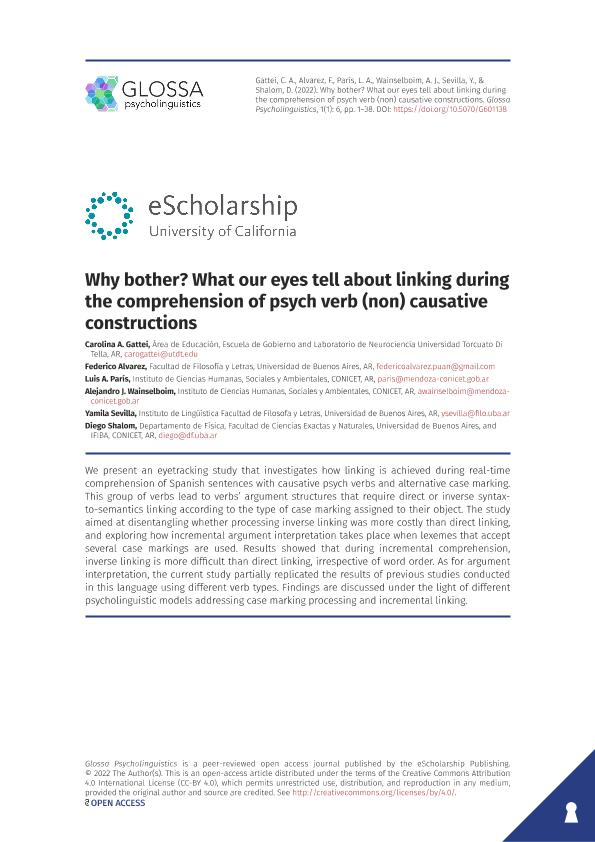Artículo
Why bother? What our eyes tell about psych verb (non) causative constructions
Gattei, Carolina Andrea ; Alvarez, Federico; Paris, Luis Alberto
; Alvarez, Federico; Paris, Luis Alberto ; Wainselboim, Alejandro Javier
; Wainselboim, Alejandro Javier ; Sevilla, Yamila Alejandra
; Sevilla, Yamila Alejandra ; Shalóm, Diego Edgar
; Shalóm, Diego Edgar
 ; Alvarez, Federico; Paris, Luis Alberto
; Alvarez, Federico; Paris, Luis Alberto ; Wainselboim, Alejandro Javier
; Wainselboim, Alejandro Javier ; Sevilla, Yamila Alejandra
; Sevilla, Yamila Alejandra ; Shalóm, Diego Edgar
; Shalóm, Diego Edgar
Fecha de publicación:
07/2022
Editorial:
eScholarship Publishing
Revista:
Glossa Pycholinguistics
ISSN:
2767-0279
Idioma:
Inglés
Tipo de recurso:
Artículo publicado
Clasificación temática:
Resumen
We present an eyetracking study that investigates how linking is achieved during real-time comprehension of Spanish sentences with causative psych verbs and alternative case marking. This group of verbs lead to verbs’ argument structures that require direct or inverse syntaxto-semantics linking according to the type of case marking assigned to their object. The study aimed at disentangling whether processing inverse linking was more costly than direct linking, and exploring how incremental argument interpretation takes place when lexemes that accept several case markings are used. Results showed that during incremental comprehension, inverse linking is more difficult than direct linking, irrespective of word order. As for argument interpretation, the current study partially replicated the results of previous studies conducted in this language using different verb types. Findings are discussed under the light of different psycholinguistic models addressing case marking processing and incremental linking.
Palabras clave:
SENTENCE PROCESSING
,
CAUSATIVE PSYCH VERBS
,
EYE TRACKING
,
WORD ORDER
Archivos asociados
Licencia
Identificadores
Colecciones
Articulos(INCIHUSA)
Articulos de INST. DE CS. HUMANAS, SOC. Y AMBIENTALES
Articulos de INST. DE CS. HUMANAS, SOC. Y AMBIENTALES
Articulos(SEDE CENTRAL)
Articulos de SEDE CENTRAL
Articulos de SEDE CENTRAL
Citación
Gattei, Carolina Andrea; Alvarez, Federico; Paris, Luis Alberto; Wainselboim, Alejandro Javier; Sevilla, Yamila Alejandra; et al.; Why bother? What our eyes tell about psych verb (non) causative constructions; eScholarship Publishing; Glossa Pycholinguistics; 1; 1; 7-2022; 1-38
Compartir
Altmétricas



